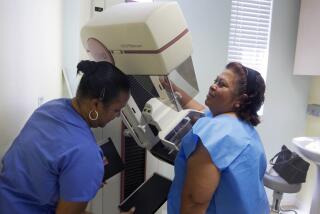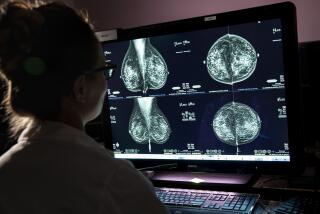High False-Positives, Experts Say of Tests
- Share via
Mammograms are a test with important limitations, and those limits are especially pronounced for women in their 40s--exactly the group for whom Health and Human Services Secretary Tommy G. Thompson is now urging screenings at least every two years.
For starters, medical experts say, mammograms have a high rate of anxiety-provoking false-positives. In those cases, the test detects a suspicious lesion that later turns out to be benign.
“For every 100 women that have an abnormality, only 20 of them will have cancer,” said Dr. Melvin J. Silverstein, professor of surgery and director of the Breast Center at the USC/Norris Cancer Center.
The large number of false-positive readings is a key factor in the debate over the usefulness of mammograms. The high rate of false-positives means that many women are subjected to biopsies and other forms of exploratory surgery that are unnecessary.
That would seem a cost worth paying if early detection of tumors clearly lead to more effective treatments. But, critics of mammograms say, the record is not so clear. In many cases, they argue, the most dangerous tumors simply cannot effectively be treated regardless of when they are found.
On the other side of the equation, while mammography often uncovers tumors when they are small, the test only spots breast abnormalities 80% to 90% of the time, which means 10% of tumors are missed. “There are some types of breast cancers that can’t be picked up by routine screenings,” said Dr. Lawrence Bassett, director of the Iris Cantor Center for Breast Imaging at the UCLA Jonsson Comprehensive Cancer Center.
In younger women, because their breast tissue is relatively dense, detection rates are even lower, and mammograms can miss up to one-quarter of tumors or early-stage cancers, which usually show up as white calcification spots on an X-ray.
On a mammogram, fatty tissue looks black, and everything else--glands, tissue, tumors--looks white and stands out in stark contrast. But denser tissue appears darker in a mammogram, so abnormalities don’t show up as clearly.
Cancers in younger women tend to be more aggressive, which makes earlier detection even more crucial. Because of the test’s limitations, doctors and breast cancer activists worry women will get lulled into a false sense of security if they get a clean bill of health from a mammogram. Consequently, the American Cancer Society recommends use of three tests for breast cancer detection in women with no symptoms: mammography, a monthly self-examination and a thorough breast exam at least once a year by a physician or other health-care professional.
“We need to do a better job of educating women about what mammograms can and cannot do,” said Judy Perotti, director of patient services for Y-Me National Breast Cancer Organization in Chicago. “We need to have more realistic expectations.”






